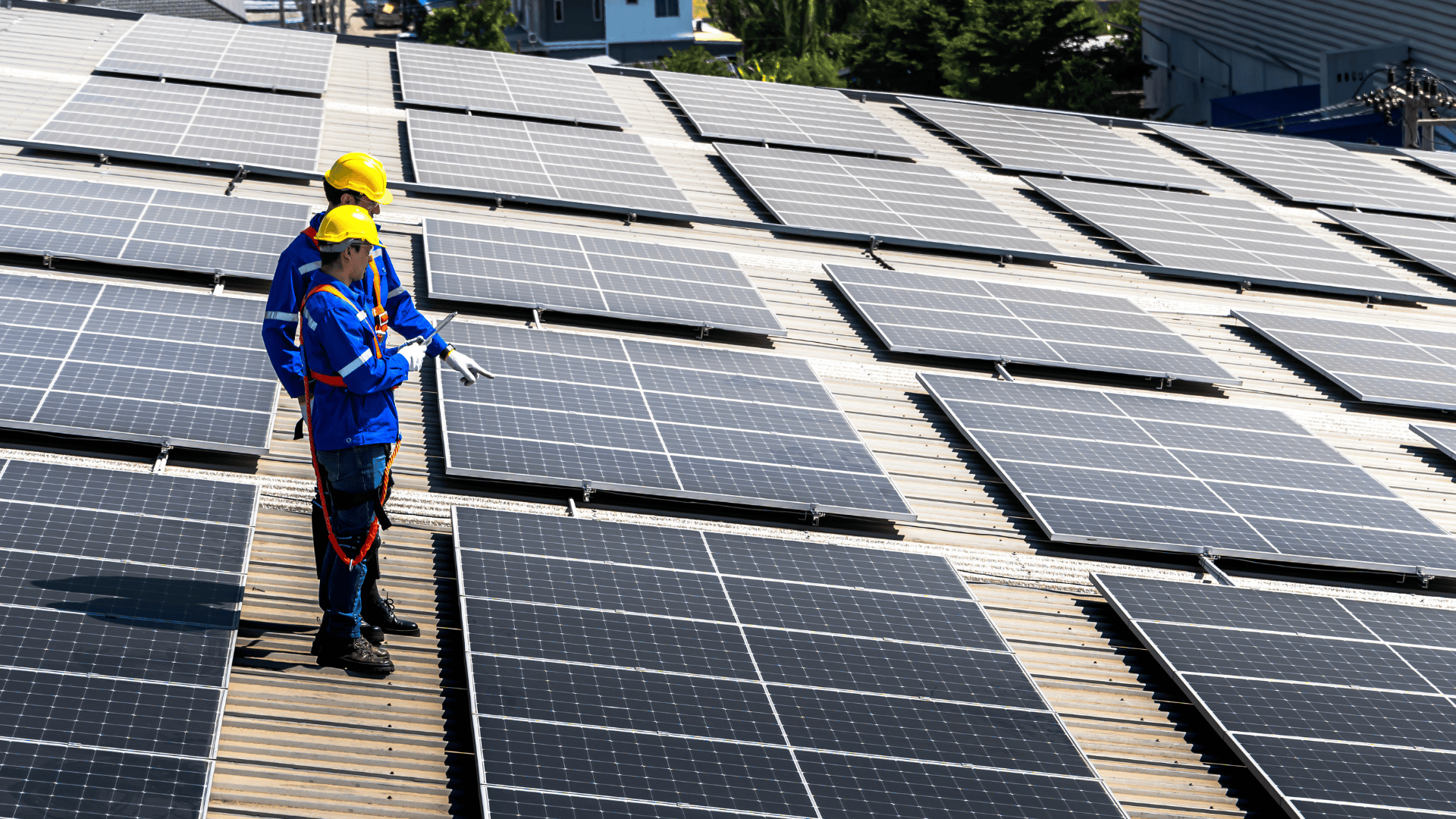May 10, 2022
Imagine this: your solar panels are soaking up the sun, powering your home, and at the same time, making you money.
This is the reality for many homeowners who sell excess solar energy back to the grid. In fact, in states like California, some homeowners can earn up to $3,000 a year just by exporting extra electricity.
As solar adoption grows, more Americans are discovering how this clean energy option not only cuts their energy bills but also offers a potential revenue stream.
Let’s explore how much you could earn by selling power back to the grid and what factors influence your earnings.
Do Utility Companies Pay for Excess Solar Energy?
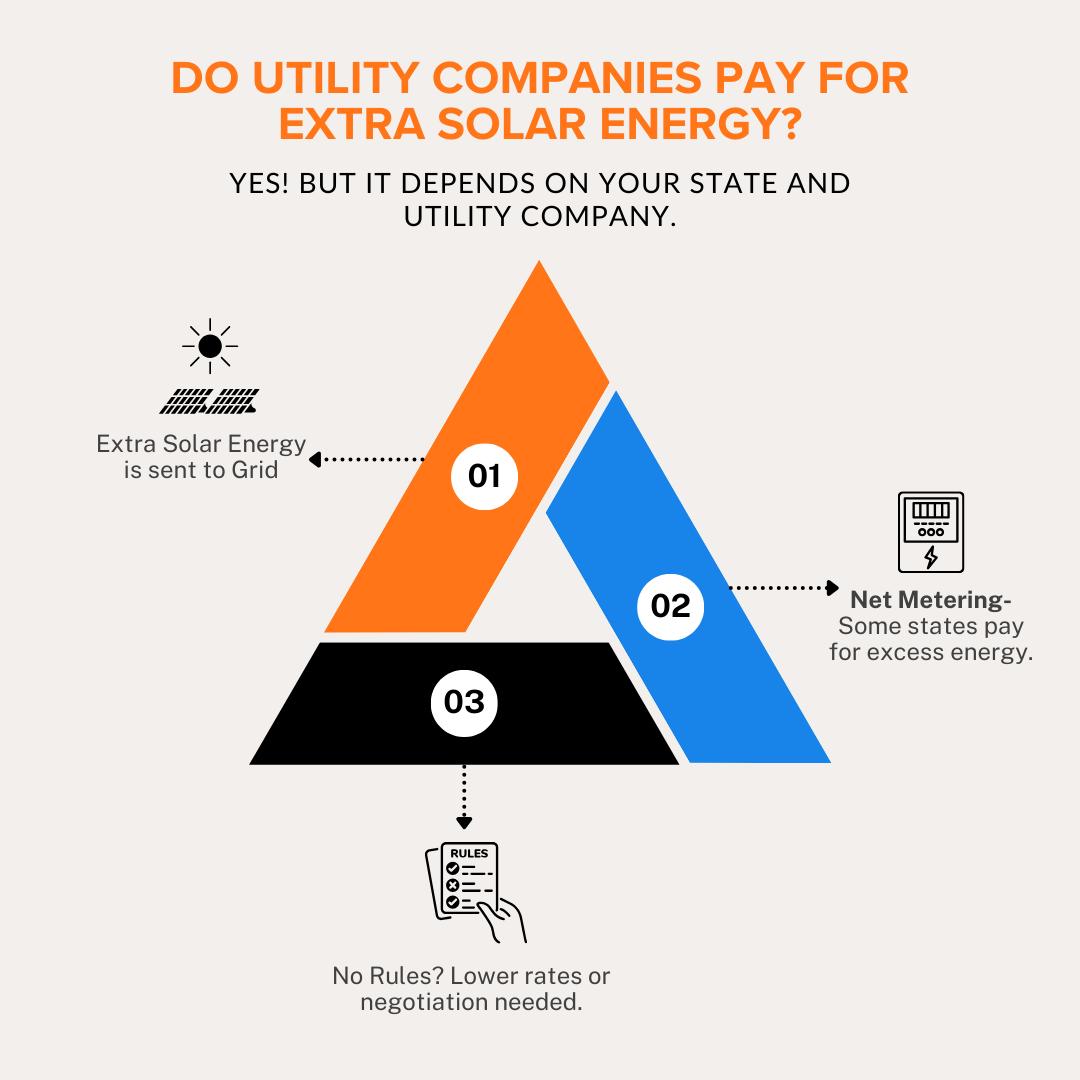
The short answer is—yes, many utility companies do pay for excess solar energy. However, the details vary depending on where you live and which utility company serves your area.
How much you can earn by selling energy back to the grid depends on a few key factors: your energy usage, how many kilowatt-hours (kWh) your solar system generates, and the incentives offered by your state and utility company.
Here’s a deeper look:
You’ll first need to determine if your utility company offers compensation for solar energy sent back to the grid. Some states have net metering laws that require utility companies to pay homeowners for the excess energy produced by their solar panels. These states often mandate a specific rate per kWh, ensuring that you’re fairly compensated.
However, if your state doesn’t have clear rules or regulations about how much utility companies must pay for excess energy from renewable energy sources, the situation can be different.
In these cases, your utility company might offer lower rates, or you may have to negotiate the best price or credit for the energy you produce. If their offer isn’t favorable, you might even need to consider switching to a utility company that provides better incentives for solar power generation.
Understanding your state’s policies and your utility company’s rules is essential to maximizing your earnings when selling energy back to the grid.
What is Net Metering?
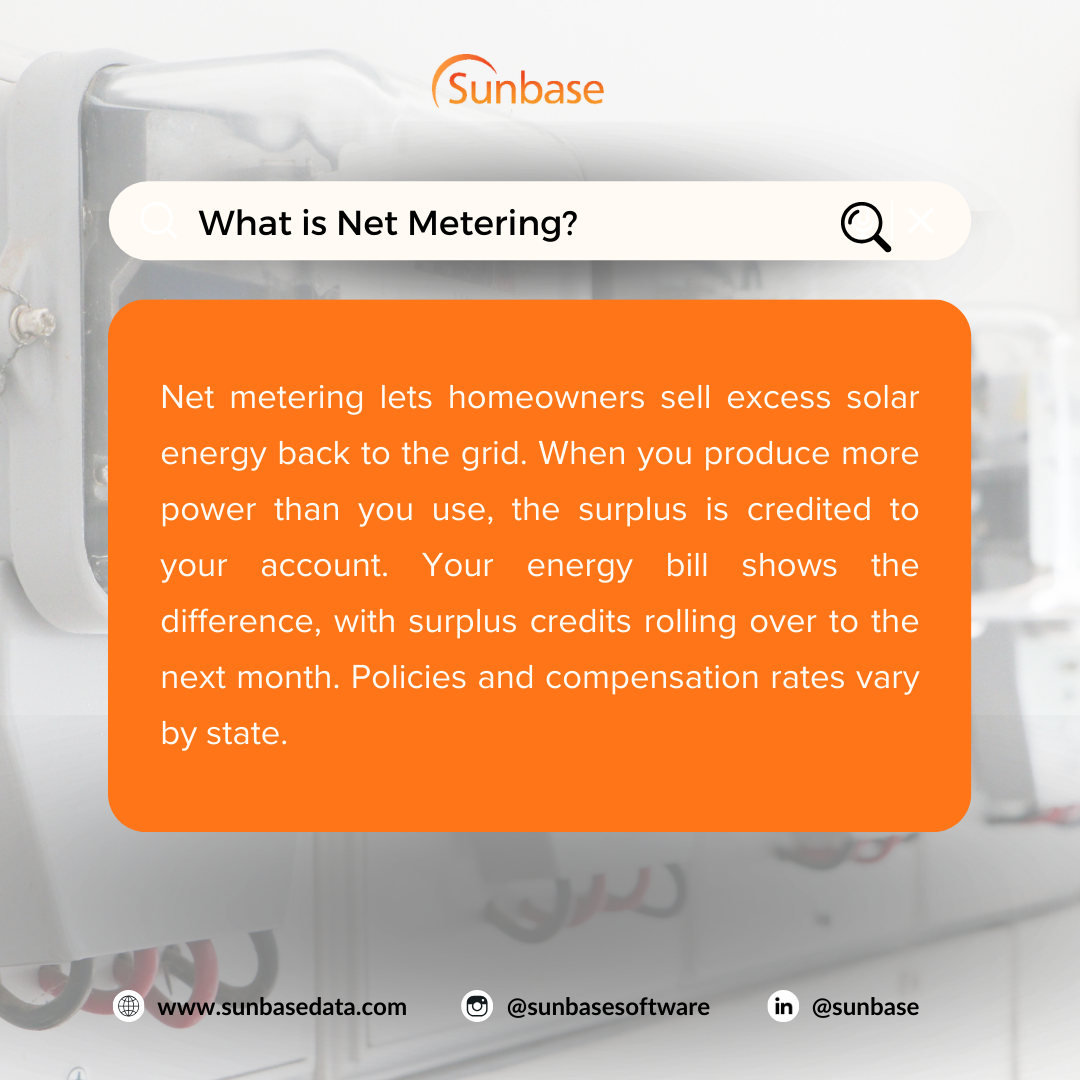
Net metering is a simple, yet powerful system that allows homeowners to sell any excess electricity their solar panels produce back to the grid.
Here’s how it works: your solar panels generate electricity, which powers your home. On sunny days, when your panels produce more energy than you need, the surplus is sent to your utility company. Instead of going to waste, this excess energy is credited to your account, effectively “selling” power back to the grid.
This system operates on a one-to-one exchange in many states. For every kilowatt-hour (kWh) of energy you send to the grid, your utility credits you for the same amount.
At the end of the month, your energy bill reflects the difference between what you consumed and what you sent back to the grid. If you produce more energy than you consume, those credits roll over to the next billing cycle.
It’s important to note that net metering policies vary by state. States like California, New York, and Massachusetts have robust programs, while others might offer less favorable terms.
The rate at which you're compensated depends on your state’s policies and the utility company’s rates. While some offer full retail credit, others may only compensate a percentage of that. Understanding these nuances is key to maximizing your earnings when selling power back to the grid.
What are the Factors That Influence Earnings
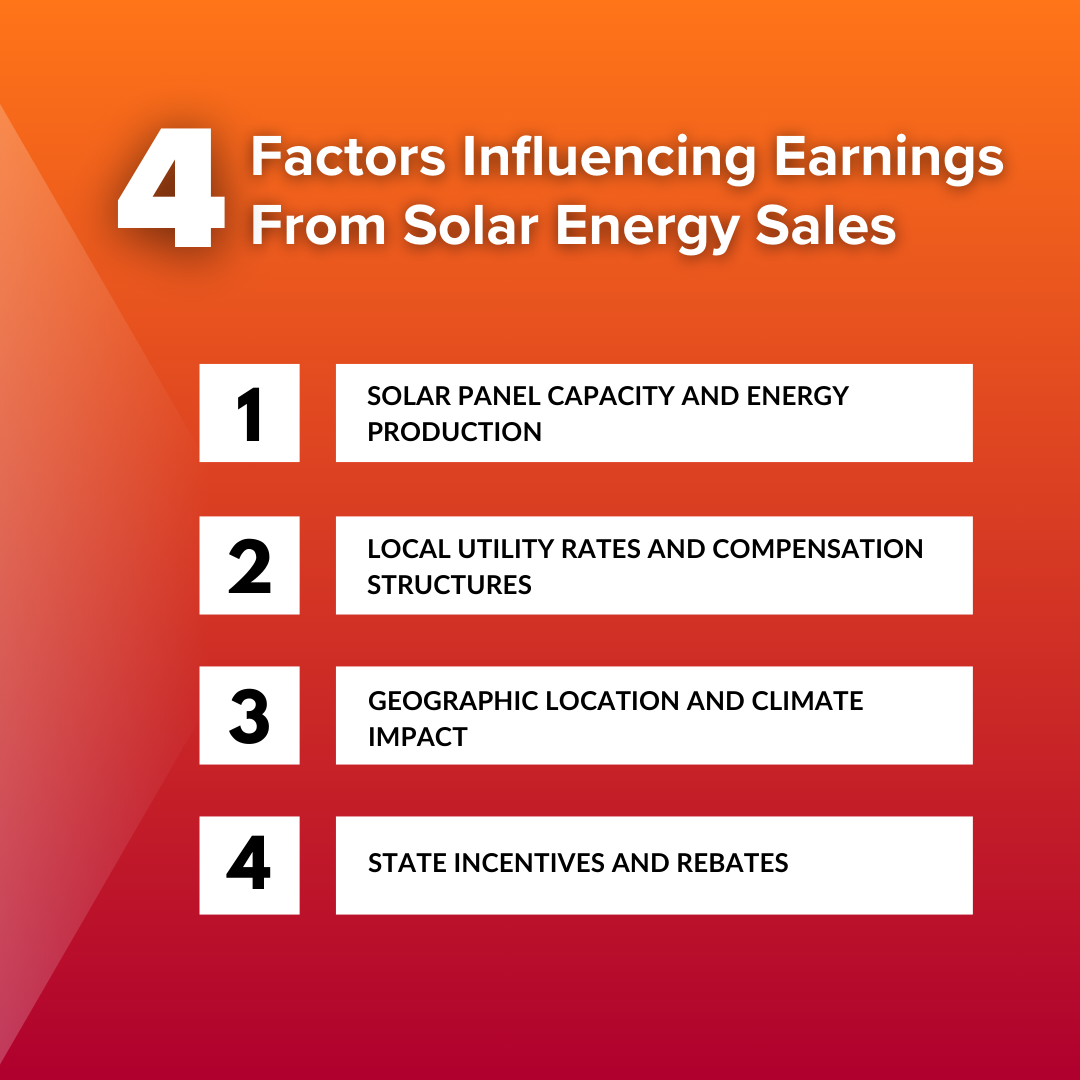
Several factors determine how much money you can make by selling power back to the grid:
1. Solar Panel Capacity and Energy Production:
The size and efficiency of your solar panel system directly affect your potential earnings. Larger systems with higher energy production capabilities will naturally generate more excess electricity, which can be sold back to the grid.
For example, a 10 kW system will produce significantly more energy than a 5 kW system, leading to more potential credits or profits.
2. Local Utility Rates and Compensation Structures:
Utility companies have different rates for purchasing excess electricity. Some offer full retail credit for every kWh you sell back, meaning you earn the same amount as you’d pay for electricity. Others may compensate you at a lower wholesale rate.
Additionally, Time-of-Use (TOU) rates can play a role; during peak hours, energy is more valuable, and your credits may be higher.
3. Geographic Location and Climate Impact:
Where you live plays a huge role in how much energy your panels produce. Sunny states like Arizona, California, and Florida see more solar production due to higher sun exposure.
In contrast, northern or cloudier states may have lower overall energy generation, reducing how much excess energy you can sell back. Local climate factors like shade from trees or buildings can also limit solar production.
4. State Incentives and Rebates:
Many states offer additional incentives and rebates that can impact your solar earnings. For instance, in California, the Self-Generation Incentive Program (SGIP) provides homeowners with financial incentives for using renewable energy, while the federal Solar Investment Tax Credit (ITC) offers a 30% credit on the cost of solar installation.
Some states have specific net metering laws that guarantee better compensation, while others may cap the amount of solar energy that can be sold back.
What are the Benefits of Selling Solar Power Back To The Grid?
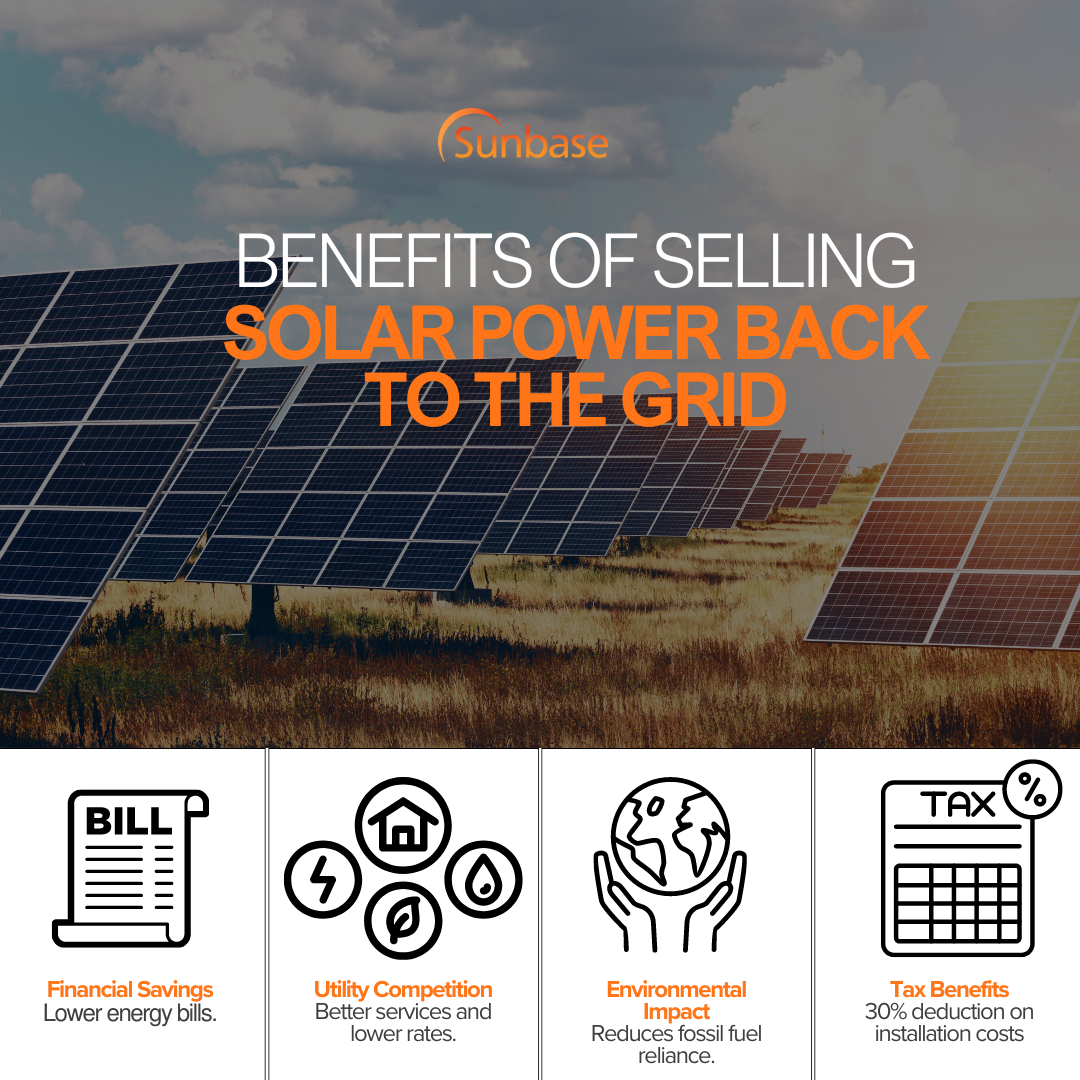
Selling solar power back to the grid offers numerous benefits, not just for you as a homeowner, but also for the environment and the broader energy market.
1. Financial Savings and Potential Earnings:
For homeowners with solar energy systems, one of the primary benefits is the potential to lower energy bills and even make extra income.
In some states, you can sell Solar Renewable Energy Certificates (SRECs), which allow you to earn additional money based on the amount of renewable power your system generates. This creates an extra financial incentive for those who invest in solar panels.
2. Utility Company Competition:
When you sell solar power back to the grid, you contribute to a more competitive energy market.
Utility companies are now incentivized to offer better service and potentially lower rates because they are competing with solar energy systems and other renewable energy source providers.
This competition can benefit all customers by pushing utility companies to improve service quality and offer more affordable pricing.
3. Positive Environmental Impact:
By exporting clean energy, you reduce the reliance on non-renewable energy sources like coal and natural gas. This helps lower carbon emissions and supports the transition to a more sustainable energy grid.
When you sell your excess renewable power, you contribute to a cleaner, more resilient energy future for everyone.
In short, selling solar power back to the grid provides both immediate financial rewards and long-term environmental and societal benefits, making it a smart choice for homeowners and the planet alike.
Tax Benefits and Incentives
When you install a solar system, you can take advantage of various tax benefits and incentives that significantly increase your financial returns.
One of the most important is the Federal Solar Investment Tax Credit (ITC), which allows homeowners to deduct 30% of the cost of installing solar panels from their federal taxes. For example, if your solar system costs $20,000, you can reduce your tax liability by $6,000.
In addition to the federal tax credit, many states also offer their own incentives. These might include state tax credits, rebates, or even performance-based incentives (PBIs), where you earn money based on how much energy your solar panels produce.
These programs help reduce the upfront cost of going solar and can shorten the payback period, meaning you’ll start saving or making money even faster.
By combining federal and state tax incentives, homeowners can dramatically lower the cost of solar installation, making the shift to renewable energy sources more financially attractive.
How Much Does Selling Energy Back Save You Monthly?
A home solar panel system can significantly reduce your monthly electric bills, potentially saving you hundreds of dollars each month.
On average, homeowners can expect savings ranging from $50 to $300 per month, depending on system size, energy consumption, and location. In states with higher electricity costs and more favorable solar policies, these savings can go up to $700 or more per month.
Over a 30-year period, the financial returns from solar energy often outperform traditional investments, thanks to reduced utility bills and potential earnings from selling excess energy.
The payback period for a solar installation typically falls between 5 and 7 years, after which homeowners continue to save and, in some cases, profit. In areas with high electricity costs, some people even see a return on investment within a few months, especially with federal tax incentives like the 30% Solar Investment Tax Credit (ITC).
Can You Sell Energy Back If You Go Completely Off-Grid?
If your family goes fully off-grid, you won’t be able to sell energy back to the grid since you're not connected to it. Selling energy back typically requires being tied to the local power grid, so off-grid systems (which store energy in batteries) wouldn’t allow for excess energy to be exported.
That said, it’s still possible to combine grid-tied solar systems with battery storage. In this case, you can store energy for emergencies like power outages and sell any surplus during peak hours.
Choosing to install a battery backup system will depend on how concerned you are about potential power disruptions. While off-grid systems give you energy independence, most homeowners prefer to stay connected to the grid, ensuring both backup power and the opportunity to sell excess energy.
How much can you make Monthly by Selling Solar Energy back to the Grid?
Depending on your state and how much power your solar panels produce, what you make by selling solar energy back to the grid might vary. But on average, you can make about $50-$700+ per month.
How much you actually get paid is dependent upon factors like how big your system is and what time of day it is producing energy. It's important that if you are planning on setting up a solar energy system, check with PG&E or another electric company for rates.
Most homeowners don’t aim to make a large profit but rather to reduce or eliminate their electricity bills. With a well-sized system in a favorable area, you can significantly offset energy costs and, in some cases, generate enough credits to carry over month to month.
In some cases, this may result in actual profit, though it’s more common for excess energy to balance out what you consume, effectively reducing your bill to near zero over the course of the year.
Is it worth selling back the energy to the grid?
When you are eager to reduce your electricity bills, then it is definitely worth selling back the energy to the grid. Doing this will not only save money but also protect you from incurring high utility costs during emergencies like power outages or bad weather!
Purchasing batteries can be an added expense which might make this option slightly less attractive financially. But if you don't want to completely go off the grid, then using solar panels and selling back energy can still save a lot of money in the long run.
The best thing that you can do is look at how much money you spend on electricity every month after all other factors have been considered and use this as a general guideline so that you know whether or not going solar could save you money in the long term!
And can end up making some extra cash every month instead of paying more in order to get their electricity from somewhere else! This means that if they're spending $200/month then it might take about 20 years before those panels start saving them significant amounts of money each year—and sometimes even longer depending on how much electricity is being produced and used.
Case Studies of Successful Homeowners
Real-world examples can offer valuable insights into the practicalities and benefits of selling power back to the grid.
Sarah’s Solar Success
Sarah from California installed a 5kW solar panel system on her rooftop. Within the first year, she not only cut her electricity bill by 80% but also earned $1,200 by selling excess power back to the grid. With state incentives and federal tax credits, her system paid for itself in just five years.
Mark’s Wind Power Solution
Mark, living in a rural area in Texas, opted for a small wind turbine. His property’s ideal wind conditions resulted in consistent power generation, earning him an additional $200 monthly. Though his initial investment was higher, the long-term benefits and low maintenance costs made it worthwhile.
Conclusion
Selling excess power from your solar system can lead to significant savings and even profits over time. The earning potential depends on factors like your location, the size of your solar panels installed, and your local net metering policies. With federal and state incentives, the financial returns from investing in renewable energy sources are more appealing than ever.
If you're considering going solar, explore local options for selling power back to the grid to see how much you could save or earn in your area. Solar energy not only benefits the environment but can also be a smart financial move for your household.
About Sunbase-
Sunbase is all-in-one management software that saves companies time and money with automation! Over 3000+ Professionals Trust Sunbase As The Platform To Manage, Build, & Grow Their Business.
Let Sunbase be your partner in achieving success in the roofing industry. For inquiries, support, or to book a demo, reach out to us here!
I agree to receive marketing messaging from Sunbase at the phone number provided above. I understand data rates will apply, and can reply STOP to OPT OUT.





